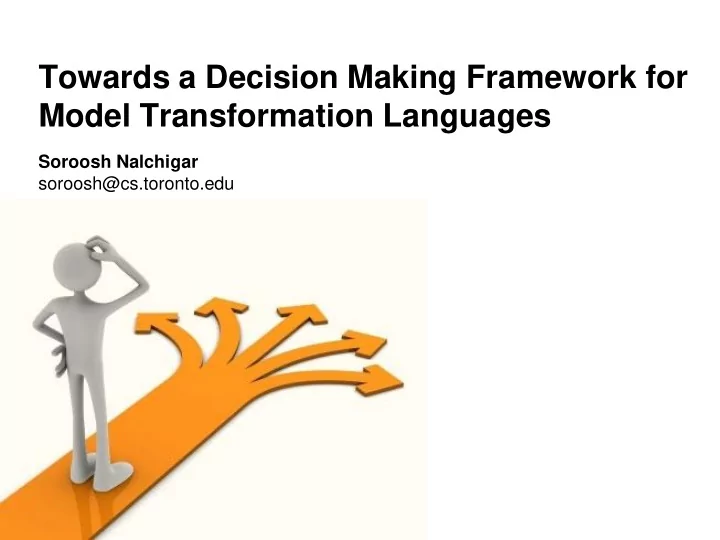

Towards a Decision Making Framework for Model Transformation Languages Soroosh Nalchigar soroosh@cs.toronto.edu
Outline • Introduction • Research problem • Proposed solution • Application (3 scenarios) • Where to go from here? 2
Introduction • Model Driven Engineering (MDE) is growing. • Model transformation is primary activity in MDE. • A wide variety of tools and languages: – QVT – ATL – AGG – … 3
Research problem • A challenging task of software engineer is to choose a particular language given a set of non- functional requirements. • Challenges: – Multiple – Intangible and difficult to measure, if not impossible – Some are conflicting 4
Research goal • The main goal of this research is to propose a decision making framework for selecting most suitable model transformation language given non-functional requirements 5
Outline • Introduction • Research problem • Proposed solution • Application (3 scenarios) • Where to go from here? 6
Non-Functional Requirements in Model Transformations • To build a decision making framework, the first step was to create a comprehensive list of non- functional requirements of model transformations. • Review of previous works 7
Comparison of Two Languages • We compared ATL and AGG with regarding to all non-functional requirements. • This was done by reviewing previous works. • Example: – ATL is capable of managing complex models because of its imperative language constructs and use of helper functions (Stephan & Stevenson, 2009). – Graph transformations are sometimes accused of generating inefficient programs or having inefficient algorithms (Mens et al. 2006). 8
Comparison of Two Languages We used qualitative contribution links since NFRs are intangible and difficult to measure. However, is this model enough for decision making? 9 It lacks a systematic way of choosing an specific alternative.
Fuzzy-AHP approach • The decision mechanism used in this paper is called Fuzzy-AHP. • Fuzzy-AHP = Fuzzy set theory + AHP 10
Fuzzy set theory • Proposed by Zadeh in 1965. • To deal with vagueness of human thought • Degree of membership is between 0 and 1. • It resembles human reasoning in its use of approximate information and uncertainty to generate decisions. “tall” in Iran Membership 1 value “tall” in USA “tall” in NBA 0 height 160cm 180cm 11
AHP • Analytic Hierarchy Process (AHP) • Proposed by Saaty in 1980. • One of the Multi-Criteria Decision- Making (MCDM) methods. • Four steps: – problem hierarchy, – judgment matrices by pairwise comparisons, – calculation of local priorities – calculation of global priorities 12
AHP • Example: Buy the best Goal Car General Criteria Handling Economy Power Secondary Braking Dist Turning Radius Purchase Cost Maint Cost Gas Mileage Time 0-60 Criteria Lexus Alternatives Ford Taurus Saab 9000 F L S F 1 3 5 L 1/3 1 3 1 13 S 1/5 1/3
Fuzzy-AHP • Step 1 . Development of problem hierarchy • Step 2 . Fuzzy comparison matrix • Step 3 . Calculation of fuzzy synthetic extents • Step 4 . Fuzzy synthetic extents are compared • Step 5 . Find minimum degree of possibilities • Step 6 . Normalization of weight vector 14
Outline • Introduction • Research problem • Proposed solution • Application (3 scenarios) • Where to go from here? 15
Case 1 • From [17] • M2M transformation • Business process models • BPMN to BPEL • Since we are dealing with business analyst, we assume that understandability, conciseness, modularity, and visualization are more important than other NFRs. 16
Case 1 • Inputs to fuzzy-AHP method form expert: • From literature: 17
Case 2 • From [1,14,45,32] • ER model from class diagram • Has been implemented in ATL, AGG, QVT, etc… • In this case we assume that all the non-functional requirements are of same level of importance. 18
Case 3 • From [6] • Large industrial context • Code generations from huge models • Important NFRs for this case: • Scalability, • Interoperability, • Standardization and • Reusability 19
Results 20
Conclusion • Main contribution of my work. • Advantages: – Introduction of fuzzy concepts to NFRs – Ease of use • Future works: – Extend the number of languages – Real experts, more than one, for fuzzy pairwise comparisons – Sensitivity analysis – And to publish it somewhere … <3 21
Recommend
More recommend